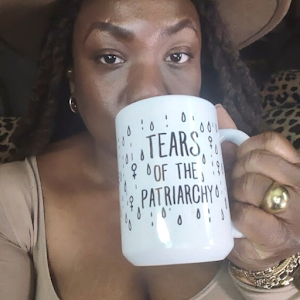FX's Exercise in Witchcraft, Sex, Gender, and Race
Prior to season three’s Coven, I’d never watched the American Horror Story series. I had a brief dalliance with the first season’s Murder House installment, but my interest waned, and I gave up after the first three episodes. I didn't bother with season two and, fortunately, American Horror Story unfolds like an anthology, and features a new story each season, so there’s no sense of urgency for late-pass stragglers like myself, to play catch up via weekend Netflix marathons.
When I learned that Angela Bassett, Kathy Bates, Jessica Lange (a series regular), and Gabourey Sidibe were among the cast for AHS: Coven and saw the gothic trailers and dark cinematic look of season three, I was giddy, primed, and ready to watch, especially after seeing Angela Bassett in one promo, languorously draped on a throne, all flawless skin and Senegalese twists, menacingly warning, “She done messed with the wrong witch.” Season Three takes place in New Orleans, at a boarding school for young witches learning how to channel their powers, evade attention from the public, and protect themselves.
When I learned that Angela Bassett, Kathy Bates, Jessica Lange (a series regular), and Gabourey Sidibe were among the cast for AHS: Coven and saw the gothic trailers and dark cinematic look of season three, I was giddy, primed, and ready to watch, especially after seeing Angela Bassett in one promo, languorously draped on a throne, all flawless skin and Senegalese twists, menacingly warning, “She done messed with the wrong witch.” Season Three takes place in New Orleans, at a boarding school for young witches learning how to channel their powers, evade attention from the public, and protect themselves.
I've always been intrigued by the idea of witches and the ways they've played out in history and on film. The events surrounding the Salem witch trials and the mass hysteria of the time, served as a stark example of how misogyny, patriarchy, and religious extremism in Colonial America, found reasons to persecute and torture women who didn't fall in line with societal norms. The trials are a fascinating and sordid chapter in New England’s history. Tituba, a 17th-century slave girl of color in Massachusetts, owned by Samuel Parris, was the first person to be accused of practicing witchcraft in the late 1600s, by Parris’s daughter and her cousin; precipitating a chain of mass hearings, prosecutions, and executions.
I’d read that AHS: Coven would be using historical references to build upon some of the narratives in the series—including the incorporation of real life characters: Bates as Delphine LaLaurie, a wealthy Louisiana bornsociopath socialite and serial murderer who routinely tortured and murdered Black slaves, and Bassett as Marie Laveau, a free-born Louisiana creole socialite, hairdresser, and Voodoo priestess. I’d also read there’d be flashbacks referencing American slavery and non-caricaturish depictions of Voodoo. Most exciting, that Gabourey Sidibe would be playing a living descendant of Tituba. Needless to say, my interest was piqued.
I’d read that AHS: Coven would be using historical references to build upon some of the narratives in the series—including the incorporation of real life characters: Bates as Delphine LaLaurie, a wealthy Louisiana born
Fast forward to October 5th: and AHS: Coven premiered with a bang. Going right for the jugular, within the hour showrunners Ryan Murphy and Brad Fulchuk gave viewers unsettling visuals of ageism, grisly slavery torture porn, a vagina dentata-type death, the gang rape of one of the principal female characters at a fraternity party, and the revenge-rape and death of a comatose frat boy as he lay in a hospital bed. But the first installment was just a warm-up for what was to come; specifically since last Wednesday’s ‘The Replacements’ episode left me in need of a hot bath and a stiff drink.
While it’s evident that Ryan and Brad have zero interest in coddling viewers and AHS: Coven is undoubtedly the anathema to folks who loathe boundary pushing on network TV, the series is twisted and over-the-top enough to keep me riveted. Sue me. My film and television choices are often not for the faint of heart, and I’m mostly clocked-in for Angela Bassett's unmarred beauty and ‘no time for your shit’ Voodoo queen shade. That aside, I find the portrayal of Gabourey Sidibe's character, Queenie, extremely problematic and disturbing so far.
While it’s evident that Ryan and Brad have zero interest in coddling viewers and AHS: Coven is undoubtedly the anathema to folks who loathe boundary pushing on network TV, the series is twisted and over-the-top enough to keep me riveted. Sue me. My film and television choices are often not for the faint of heart, and I’m mostly clocked-in for Angela Bassett's unmarred beauty and ‘no time for your shit’ Voodoo queen shade. That aside, I find the portrayal of Gabourey Sidibe's character, Queenie, extremely problematic and disturbing so far.
Writers have taken, what could be, a compelling character—she’s a ‘human voodoo doll’ who’s immune to pain (also problematic) and is able to inflict physical discomfort on her enemies via self-harm—and have made her into one of the most erroneous Black female TV tropes.
Instead of giving us a titillating back-story and offering viewers some insight into how Queenie—who’s, once again, connected to one of the most elusive and interesting historical figures to emerge from the Salem witch trials— became attuned to her powers. Instead, they’re f*cking trying to create ‘Precious 2.0’, and it’s disappointing, because since Gabourey’s riveting turn as the disenfranchised, obese, and abused young Black woman in Precious, she’s expounded on her body of acting work and is an immense talent.
But alas, Sidibe can’t seem to supplant her Precious legacy. Hollywood and the masses won’t let her, despite her desire to play more challenging roles, because people refuse to differentiate between Gabourey, the actress and Precious, the character. And so we get a brief peek into Queenie’s background via a flashback to 2012, of her frying chicken in a Detroit fast food joint, touting her stellar mathematical gifts to a doubtful, rude, and hectoring customer, right before sticking half her arm in a deep fryer to inflict pain on him.
Queenie, the fat Black sass-muffin, whose dialogue is peppered with unnecessary food references (she threatened to cannibalize a fellow witch-in-training during an argument), and who is shown making a late-night visit to the fridge in an earlier episode because, of course, the only thing fat women think and talk about, is food... and nothing else.
Queenie seems to serve as fodder for the supposed undesirability, crudeness, and unworthiness of fat Black women; so in last week’s third and most disturbing episode, Queenie got hot for, and possibly had sex with, a former-slave turned Minotaur—a whole other racial implication that plays on the stereotype of Black men as unhinged insofar as being a brute—while social media collectively ewwwed and eeked at the sight of an overweight Black woman pleasuring herself on TV, ‘cause apparently, fat actresses haven’t earned the right to express sexuality onscreen. Go figure.
Writers have done a relatively good job with how they’ve depicted Jamie Brewer (an actress with Down Syndrome) and her clairvoyant character. So can they please cut a sistah a damn break and elevate Gabourey’s Queenie from a gluttonous Mammy caricature, to a young witch with an interesting history that extends beyond fried chicken grease and food quips? I know we’re barely four episodes in, but I’m getting antsy that she'll be misused and underutilized.
 I can’t imagine how else AHS: Coven will ruffle its viewers, as these past few episodes seem to have only scratched the surface of the underbelly. Although I’m disappointed with the hand Gabourey has been dealt so far, I intend to push onward to the end.
I can’t imagine how else AHS: Coven will ruffle its viewers, as these past few episodes seem to have only scratched the surface of the underbelly. Although I’m disappointed with the hand Gabourey has been dealt so far, I intend to push onward to the end.
The controversial story arcs notwithstanding, AHS: Coven offers some interesting commentary on gender, race, privilege, and cultural appropriation; and some of the juiciest dialogue about the latter comes from Angela Bassett in her turn as Marie Laveau, when she tells 'Supreme' witch, Fiona (played by Lange) that the origins of witchcraft in New Orleans began in Africa with the ancestors, and that Fiona's folk just stole it.











No comments
Post a Comment